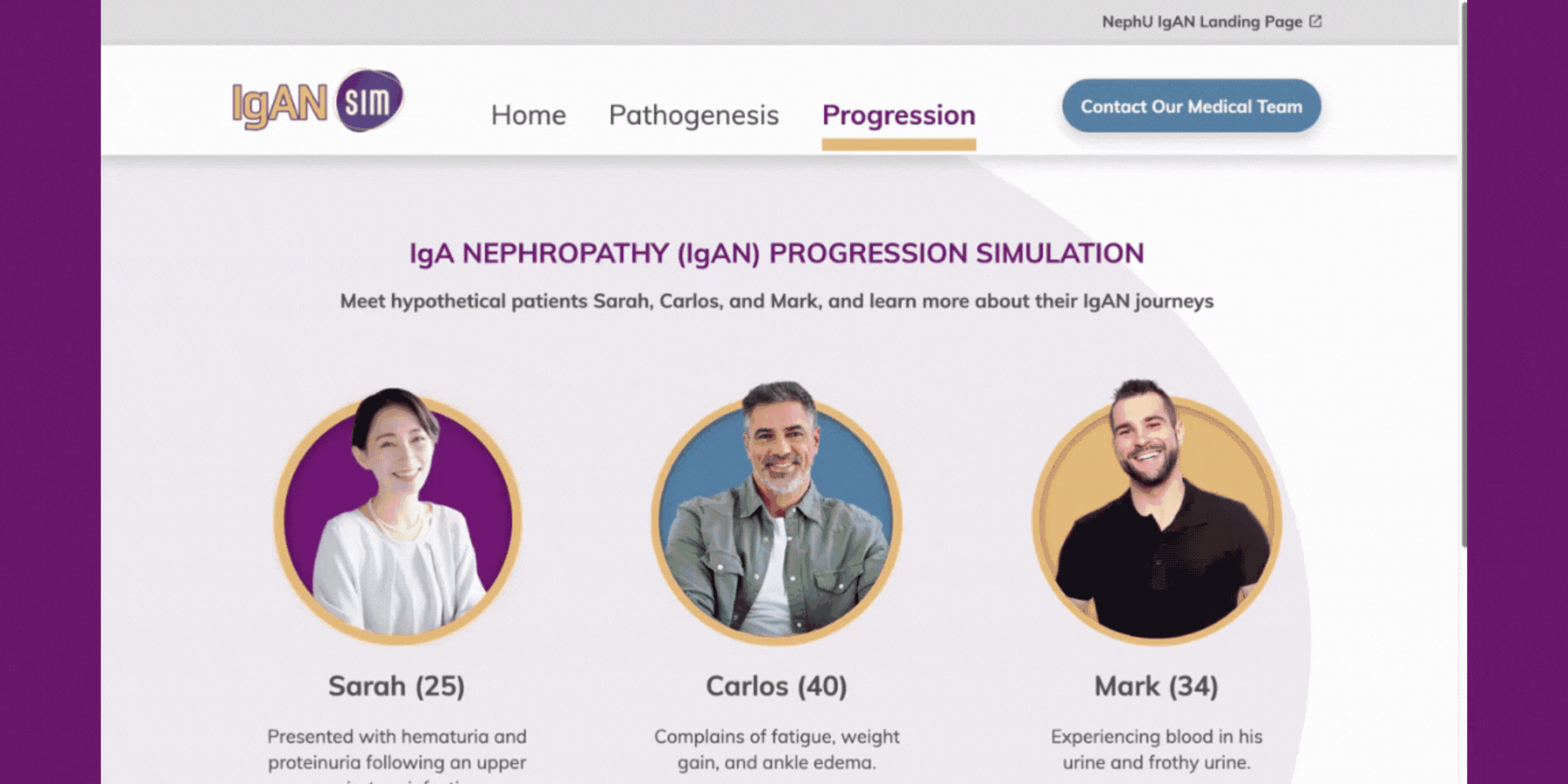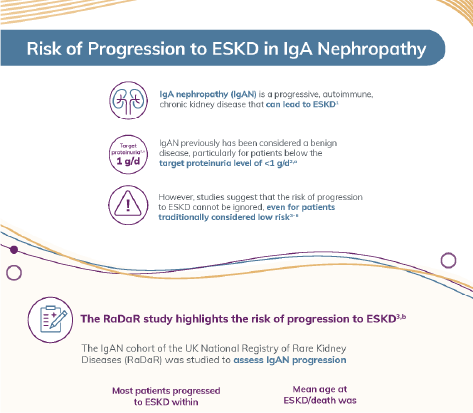IgA Nephropathy (IgAN) Progresses to ESKD in the Majority of Patients1
IgAN develops through the 4-hit cascade driven by Gd-IgA1. APRIL, a B-cell growth factor that promotes Gd-IgA1 production, is associated with progression to ESKD.2-4

FEATURED CONTENT

IgAN Simulator
Dive into the molecular world of IgAN, and simulate IgAN progression using prognostic tools and patient risk factors.
The Role of APRIL in IgA Nephropathy
Learn about the pathogenic cascade that causes kidney injury and about APRIL, an initiating and sustaining factor in IgAN.2

Understanding IgAN pathogenesis, progression, and management is critical for improving IgAN patient care. NephU has gathered expert-led resources and webinars to encourage ongoing disease education. Visit our Resource Center for more information.
Mechanism of Disease
Pathogenesis and the Role of APRIL
IgAN develops through the 4-hit cascade initiated by the production of Gd-IgA1. APRIL is an important initiating and sustaining factor in IgAN progression by promoting the production of Gd-IgA1 and immune complex formation.2

INFOGRAPHIC
APRIL and the 4-Hit Pathogenic Cascade of IgAN
This infographic highlights the role of APRIL in a
pre-hit 1 step that drives the 4-hit cascade.2

ON-DEMAND WEBINAR
The 4-Hit Cascade & The Role of APRIL in IgAN
Drs Rizk and Norouzi discuss the IgAN pathogenic cascade and APRIL, an important initiating and sustaining factor in this process.2

AUDIO/PODCAST
Hot Topics in Nephrology: Taking a Deeper Dive into the 4-Hit Cascade in IgA Nephropathy – The Role of APRIL – NephU
Dr Norouzi highlights the importance of APRIL in the initiation and progression of IgAN.2
Disease Burden and Progression
IgAN Burden and Progression to ESKD
IgAN is the most common primary glomerulonephritis in the world and a leading cause of chronic kidney disease.5,6 In observational studies, most patients with IgAN develop ESKD within 10-15 years of diagnosis.1,7-9

INFOGRAPHIC
Overview of IgAN
This infographic focuses on IgAN diagnosis, prognosis, and disease management strategies.

INFOGRAPHIC
Risk of Progression to ESKD in IgA Nephropathy
This infographic highlights the risk of progression to ESKD, including in patients traditionally considered low risk.

WEBINAR
Understanding the IgAN Patient Journey
Listen as IgAN patient and nephrology healthcare provider Kelly Chen describes the physical, mental, and emotional toll of this chronic, progressive disease.

INFOGRAPHIC
How Does IgAN Affect Individuals Based on Differences in Ethnicity, Race & Sex?
Dr Murakami highlights how unique patient characteristics impact IgAN incidence and outcomes.
Disease Management
Risk Evaluation and IgAN Management
Despite treatment with optimized supportive care, many patients with IgAN remain at risk of developing ESKD.10

INFOGRAPHIC
Understanding the Benefits and Risks of Corticosteroid Use in Patients With IgAN
This infographic highlights clinical trial results showing mixed efficacy and increased adverse events in patients with IgAN treated with corticosteroids.

VIDEO
Updates in IgA Nephropathy- Part 1
Listen as Dr. Rovin, co-chair of the committee updating the KDIGO Guidelines for IgAN, discusses recent advancements in IgAN management.

WEBINAR
Utilization of the International IgA Nephropathy Prediction Tool
What tools can you use to assess your patient’s risk of progression based on their individual characteristics? Dr Shah explains how to harness the Prediction Tool for a more thorough evaluation.

WEBINAR
The Role of the Renal Pathologist
Dr. Hassler, renal pathologist and IgAN patient, offers insights into the histopathological features that are crucial for accurate diagnosis and risk stratification in IgA nephropathy, highlighting the significance of the renal biopsy and its interpretation.

Resource Center
As a member of the NephU community, you can access a complete resource library for ongoing education. Together, we can improve IgAN care and ease the burden of this chronic, progressive disease.
APRIL, a proliferation-inducing ligand; ESKD, end-stage kidney disease; Gd-IgA1, galactose-deficient IgA1; IgAN, IgA nephropathy; MEST-C, mesangial hypercellularity (M), endocapillary hypercellularity (E), segmental sclerosis (S), tubular atrophy and interstitial fibrosis (T), crescent (C).
References
1. Pitcher D, et al. Clin J Am Soc Nephrol. 2023;18(6):727-738. 2. Mathur M, et al. J Clin Med. 2023;12(21):6927. 3. Cheung CK, et al. Front Nephrol. 2024;3:1346769. 4. Han SS, et al. J Am Soc Nephrol. 2016;27(11):3430-3439. 5. Lai KN, et al. Nat Rev Dis Primers. 2016;2:16001. 6. Cattran DC, et al. Kidney Int Rep. 2023;8(12):2515-2528. 7. Wong K, et al. Lancet. 2024;403(10433):1279-1289. 8. Sim J, et al. Kidney Int Rep. 2024;9(4):S157-S158 (abstr WCN24-1268).
9. Barbour SJ, et al. Kidney Int. 2013;84(5):1017-1024. 10. Lafayette R, et al. Kidney Int Rep. 2023;8(3):S258 (abstr WCN23-0383).

